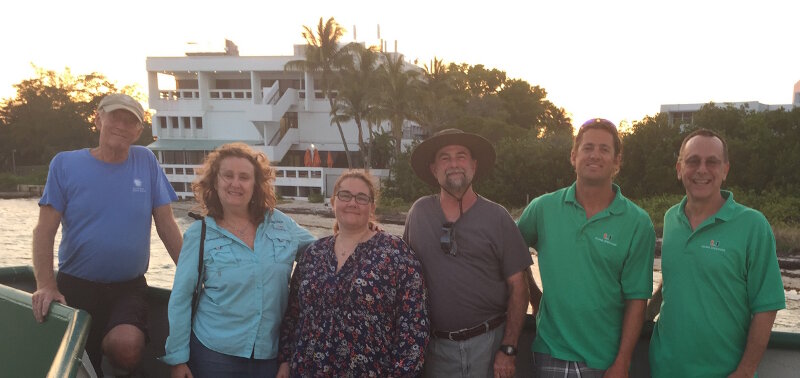
By John Reed, Research Professor & Chief Scientist - Harbor Branch Oceanographic Institute at Florida Atlantic University
May 15, 2017

Before casting off from dock in Miami, the scientific party (from left to right) of John Reed, Cris Diaz, Stephanie Farrington, Lance Horn, and Jason White are joined by Rich Behn, UM’s Director of Marine Operations. Image courtesy of Cuba’s Twilight Zone Reefs and Their Regional Connectivity. Download high resolution image (jpg, 470 KB).
Nearly a year and a half has passed since we began our deliberations for going to Cuba on a research cruise. Although the shallow reefs of Cuba are fairly well known, no one to my knowledge has studied Cuba’s deepwater reefs. Our expedition will be true exploration, and virtually every dive will provide new discoveries while documenting the coral reefs beyond scuba depths.
Planning for this research cruise took a team of dedicated individuals. First, a proposed Science Plan had to be developed (see Mission Plan), which included the overall purpose, objectives, methods, and proposed dive sites. The funding had to be secured for a month of time on the University of Miami’s R/V Walton Smith, the University of North Carolina at Wilmington’s Mohawk remotely operated vehicle (ROV), and for the scientists. The ship and ROV time had to be scheduled a year ahead of time.
Then over the year, our team of scientists was developed and our Science and Cruise Plans were finalized. At last count, I had nearly 800 emails in preparations for this cruise.
List of Cuban Scientists for the R/V Walton Smith Expedition in Cuba (May 15 – June 13, 2017), listed with their specialty, institution and port of boarding.
As we were packing the van to take the U.S. scientists and all their gear to meet the ship at the University of Miami's dock at Rosenstiel School of Marine and Atmospheric Science (RSMAS), I still was not convinced that the cruise was going to happen. A lot of loose ends just finished in the last few days.
Yesterday, the van loaded to the brim, we headed out for a three-hour drive to the ship. We loaded the ship as storms brewed in the distance. The ROV crew was already on board and securing their gear. The ship's crew were scrambling like all ship's crew do in the last hours before departure.
With our gear unloaded and somehow all squeezed into the space of the labs, I took a dip in the cool waters of Bear Cut between RSMAS and Key Biscayne. As I floated, I drifted back 50 years, when I was a undergraduate student at UM and taking my first marine biology course at RSMAS. And here I am going out on the UM ship to explore the unkown reefs of Cuba.
Finally, at 9 p.m., we pulled away from the dock for our 30-hour journey to Havanna. A wave of relief and satisfaction flowed through me. Not exuberant celebration, just calm. Jason, the ROV pilot, gave me a high five on the back deck. We really did it, the cruise is underway!